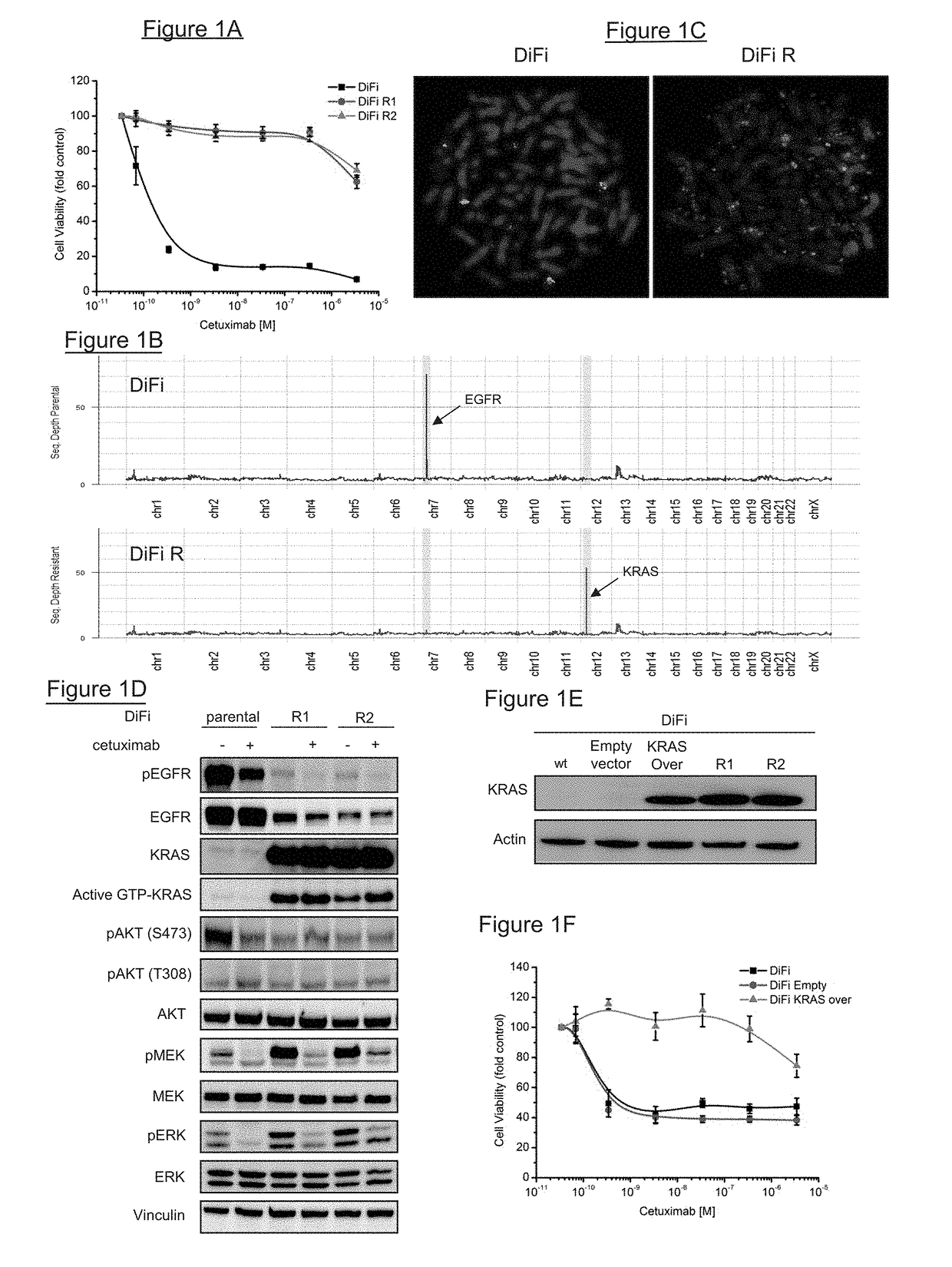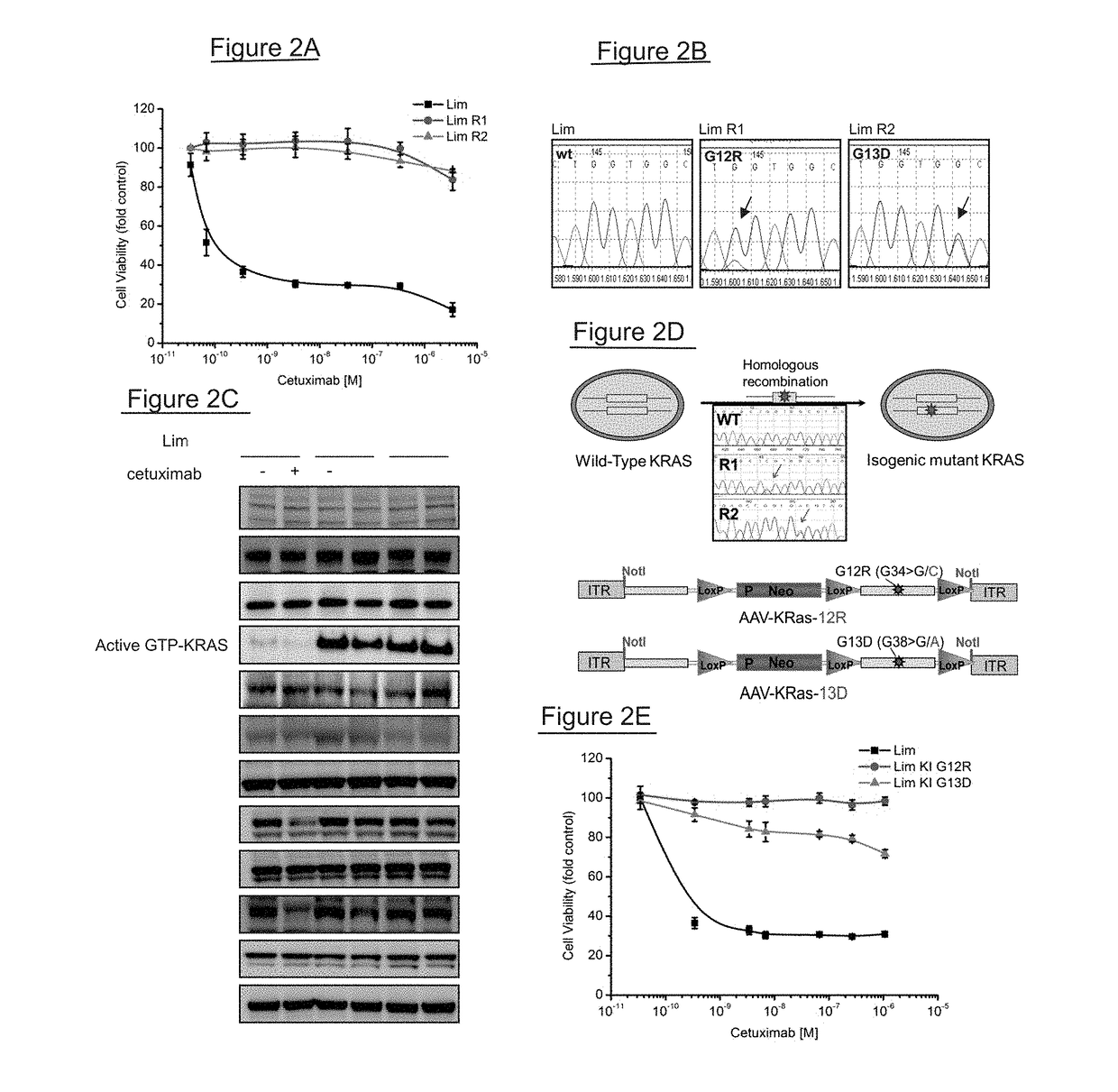Kras mutations and resistance to Anti-egfr treatment
a mutation and anti-egfr technology, applied in the field of kras mutations and resistance to anti-egfr treatment, can solve the problems of secondary drug resistance and limit the clinical benefit of this drug, and achieve the effect of preventing, reducing or delaying the onset of drug resistan
- Summary
- Abstract
- Description
- Claims
- Application Information
AI Technical Summary
Benefits of technology
Problems solved by technology
Method used
Image
Examples
example 1
nd Materials
[0065]DiFi and Lim1215 were exposed to different doses of cetuximab as described in figure S2 to obtain the resistant variants. Cell viability was assessed by ATP content. Cells were seeded in 100 μl medium in 96-well plastic culture plates. The experimental procedures for knock in of cancer mutations, the vectors, AA V production, cell infection and screening for recombinants have already been described elsewhere.
[0066]Tumor specimens were obtained through protocols approved by the Institutional Review Board of Memorial Sloan-Kettering Cancer Center (protocol 10-029) and Ospedale Niguarda Ca′Granda, Milano, Italy (protocols 1014 / 09 and 194 / 2010). Details about the clinical characteristics of patients are provided in Table 2. Identification of cancer mutations in the KRAS, HRAS, NRAS, BRAF, PIK3CA and EGFR genes was performed with different sequencing platforms (Sanger, 454 pyrosequencing and Mass Spectrometry) as described herein.
[0067]For immunoblot analysis, total cel...
example 2
ure and Generation of Resistant Cells
[0068]DiFi cells were cultured in F12 medium (Invitrogen) supplemented with 5% FBS and Lim1215 cells were cultured in RPMI-1640 medium (Invitrogen) supplemented with 5% FBS and Insulin (1 μg / ml). DiFi parental cells were plated in 100 mm Petri dishes with 2.5% FBS and exposed to a constant dose of cetuximab (350 nM), for one year in order to obtain the resistant counterpart DiFi R1. The DiFi R2 derivative was obtained by increasing cetuximab dosage stepwise starting from 3.5 nM, to 35 nM and finally to 350 nM during the course of one year. The same protocols were applied to Lim1215 with variations regarding cetuximab concentrations: for Lim R1 cetuximab was used at 1400 nM and for Lim R2 drug concentration started from 350 nM, to 700 nM and finally 1400 nM. For Lim1215 both protocols required at least 3 months' drug treatment. The Lim1215 parental cell line had been described previously (Whitehead, R. H., Macrae, F. A., St John, D. J. & Ma, J. A ...
example 3
ility Assays
[0069]Cetuximab was obtained from Pharmacy at Niguarda Ca′ Granda Hospital, Milan, Italy. AZD6244 and GSK1059615 were purchased from Sequoia Chemicals (Pangbourne, UK) and Selleck Chemicals (Houston, USA), respectively. Cell lines were seeded in 100 μi medium at appropriate density (5×104, 1.5×104 for DiFi and Lim1215 cells, respectively) in 96-well plastic culture plates. After serial dilutions, drugs in serum free medium were added to cells and medium-only containing wells were added as controls. Plates were incubated at 37° C. in 5% CO2 for 72-168 h, after which cell viability was assessed by ATP content using the CellTiter-Glo® Luminescent Assay (Promega Madison, Wis., USA).
PUM
 Login to View More
Login to View More Abstract
Description
Claims
Application Information
 Login to View More
Login to View More - R&D
- Intellectual Property
- Life Sciences
- Materials
- Tech Scout
- Unparalleled Data Quality
- Higher Quality Content
- 60% Fewer Hallucinations
Browse by: Latest US Patents, China's latest patents, Technical Efficacy Thesaurus, Application Domain, Technology Topic, Popular Technical Reports.
© 2025 PatSnap. All rights reserved.Legal|Privacy policy|Modern Slavery Act Transparency Statement|Sitemap|About US| Contact US: help@patsnap.com



